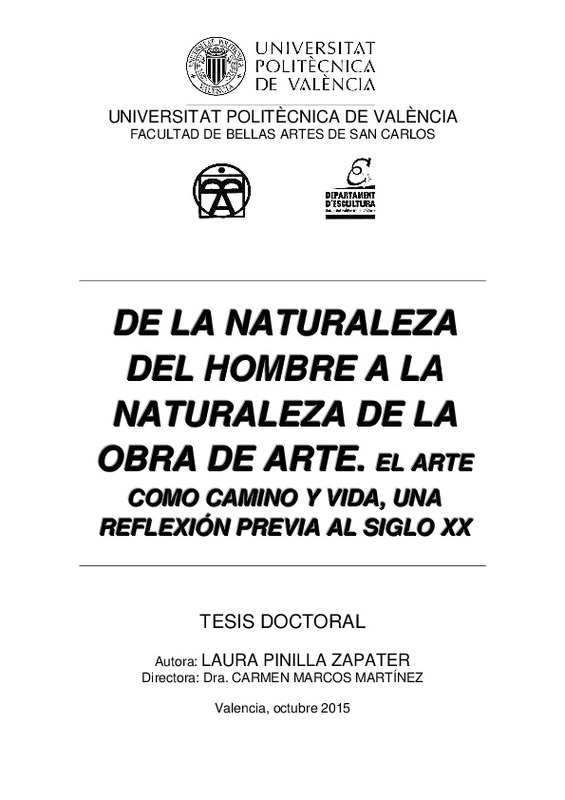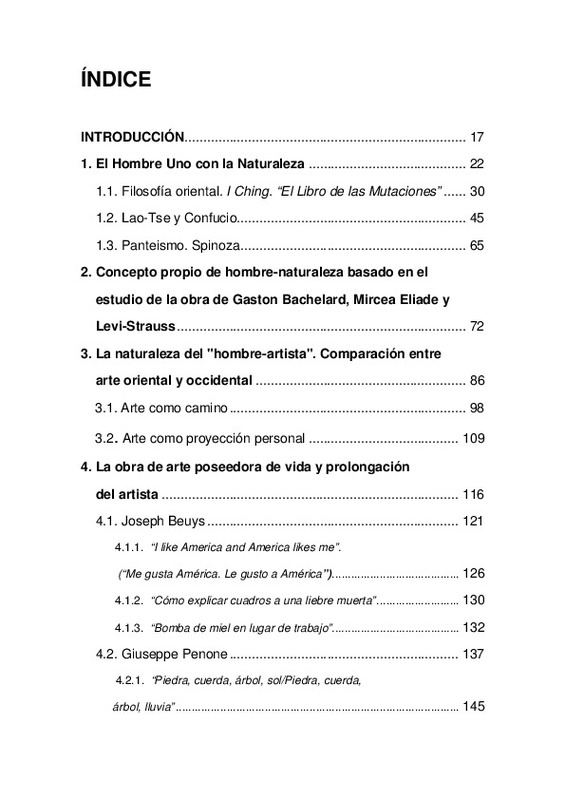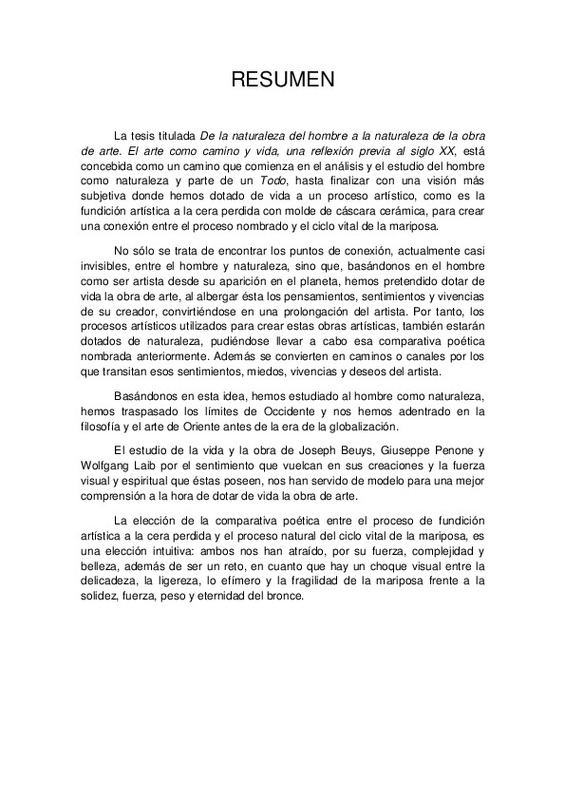|
Resumen:
|
[EN] ABSTRACT
The thesis entitled "From the nature of man to the nature of the work of art, art as pathway and life, prior to the twentieth century thinking", is conceived as a journey that begins with the analysis and ...[+]
[EN] ABSTRACT
The thesis entitled "From the nature of man to the nature of the work of art, art as pathway and life, prior to the twentieth century thinking", is conceived as a journey that begins with the analysis and study of mankind as nature and as part of a whole, to finish with a more subjective view where we have given life to the artistic process of lost wax smelting with ceramic shell, to create a connection between the mentioned process and the life cycle of the butterfly.
The question is not just finding the connection points between mankind and nature that are now almost invisible, but based on the man as an artist since his appearance on the planet, we have tried to enliven the artwork to hold this thought, feelings and experiences of its creator, becoming an extension of the artist. Therefore, the artistic processes used to create these artistic works will also be endowed with nature, being able to carry out the comparative poetics mentioned above. Besides they become paths or channels through which those feelings, fears, experiences and wishes of the artist go through.
Based on this idea, we have studied mankind as nature and we have gone beyond the limits of the western world entering the philosophy and art of the East before the era of globalization.
The study of the life and work of Joseph Beuys, Giuseppe Penone and Wolfgang Laib have been used as a model for a better understanding when it comes to give life to a work of art because of the feelings expressed in their creations and the visual and spiritual strength they have.
The choice of the poetic comparison between the artistic lost wax smelting process and the natural life cycle of the butterfly is an intuitive choice: they have both attracted us because of the strength, complexity and beauty, as well as being a challenge since there is a visual collision between delicacy, lightness, the ephemeral and the fragility of a butterfly when facing the solidity, strength, weight and eternity of bronze.
[-]
[ES] RESUMEN
La tesis titulada De la naturaleza del hombre a la naturaleza de la obra de arte. El arte como camino y vida, una reflexión previa al siglo XX, está concebida como un camino que comienza en el ...[+]
[ES] RESUMEN
La tesis titulada De la naturaleza del hombre a la naturaleza de la obra de arte. El arte como camino y vida, una reflexión previa al siglo XX, está concebida como un camino que comienza en el análisis y el estudio del hombre como naturaleza y parte de un Todo, hasta finalizar con una visión más subjetiva donde hemos dotado de vida a un proceso artístico, como es la fundición artística a la cera perdida con molde de cáscara cerámica, para crear una conexión entre el proceso nombrado y el ciclo vital de la mariposa.
No sólo se trata de encontrar los puntos de conexión, actualmente casi invisibles, entre el hombre y naturaleza, sino que, basándonos en el hombre como ser artista desde su aparición en el planeta, hemos pretendido dotar de vida la obra de arte, al albergar ésta los pensamientos, sentimientos y vivencias de su creador, convirtiéndose en una prolongación del artista. Por tanto, los procesos artísticos utilizados para crear estas obras artísticas, también estarán dotados de naturaleza, pudiéndose llevar a cabo esa comparativa poética nombrada anteriormente. Además se convierten en caminos o canales por los que transitan esos sentimientos, miedos, vivencias y deseos del artista.
Basándonos en esta idea, hemos estudiado al hombre como naturaleza, hemos traspasado los límites de Occidente y nos hemos adentrado en la filosofía y el arte de Oriente antes de la era de la globalización.
El estudio de la vida y la obra de Joseph Beuys, Giuseppe Penone y Wolfgang Laib por el sentimiento que vuelcan en sus creaciones y la fuerza visual y espiritual que éstas poseen, nos han servido de modelo para una mejor comprensión a la hora de dotar de vida la obra de arte.
La elección de la comparativa poética entre el proceso de fundición artística a la cera perdida y el proceso natural del ciclo vital de la mariposa, es una elección intuitiva: ambos nos han atraído, por su fuerza, complejidad y belleza, además de ser un reto, en cuanto que hay un choque visual entre la delicadeza, la ligereza, lo efímero y la fragilidad de la mariposa frente a la solidez, fuerza, peso y eternidad del bronce.
[-]
[CA] RESUM
La tesi titulada De la naturalesa de l`home a la naturalesa de l`obra d`art. L`art com a camí i vida, una reflexió prèvia al segle XX, està concebuda com un camí que comença en l'anàlisi i l'estudi de l'home ...[+]
[CA] RESUM
La tesi titulada De la naturalesa de l`home a la naturalesa de l`obra d`art. L`art com a camí i vida, una reflexió prèvia al segle XX, està concebuda com un camí que comença en l'anàlisi i l'estudi de l'home com a naturalesa i part d'un Tot, fins a finalitzar amb una visió més subjectiva on hem dotat de vida un procés artístic, com és la fosa artística a la cera perduda amb motle de corfa ceràmica, per a crear una connexió entre el procés esmentat i el cicle vital de la papallona.
No sols es tracta de trobar els punts de connexió, actualment quasi invisibles, entre l'home i naturalesa, sinó que, basant-nos en l'home com ser artista des de la seua aparició en el planeta, hem pretés dotar de vida l'obra d'art, perquè abraça els pensaments, sentiments i vivències del seu creador, i es convertix en una prolongació de l'artista. Per tant, els processos artístics utilitzats per a crear estes obres artístiques, també estaran dotats de naturalesa, i es podrà dur a terme eixa comparativa poètica esmentada anteriorment. A més es convertixen en camins o canals pels quals transiten eixos sentiments, pors, vivències i desitjos de l'artista.
Basant-nos en esta idea, hem estudiat l'home com a naturalesa, hem traspassat els límits d'Occident i ens hem endinsat en la filosofia i l'art d'Orient abans de l'era de la globalització.
L'estudi de la vida i l'obra de Joseph Beuys, Giuseppe Penone i Wolfgang Laib pel sentiment que bolquen en les seues creacions i la força visual i espiritual que estes posseïxen, ens han servit de model per a una millor comprensió a l'hora de dotar de vida l'obra d'art.
L'elecció de la comparativa poètica entre el procés de fosa artística a la cera perduda i el procés natural del cicle vital de la papallona, és una elecció intuïtiva: ambdós ens han atret, per la seua força, complexitat i bellesa, a més de ser un repte, ja que hi ha un xoc visual entre la delicadesa, la lleugeresa, l'efímer i la fragilitat de la papallona davant de la solidesa, força, pes i eternitat del bronze.
[-]
|











